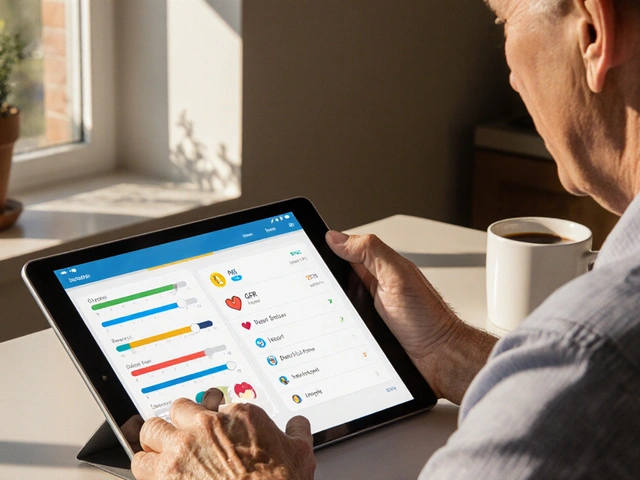Bowel Function Index Calculator
Track Your Opioid-Induced Constipation
This simple 3-question survey helps you track the severity of opioid-induced constipation. Based on your answers, you'll receive immediate guidance on whether you need to adjust your treatment.
Your score will appear here after calculation
Why Opioid-Induced Constipation Is More Than Just a Nuisance
If you're taking opioids for chronic pain, you're not alone if you're struggling with constipation. In fact, 40-60% of people on long-term opioid therapy develop opioid-induced constipation (OIC). Unlike typical constipation that fades after a few days, OIC sticks around as long as you're on opioids. It doesn’t get better on its own. And if left untreated, it can lead to nausea, bloating, vomiting, and even life-threatening bowel blockages.
Opioids work by binding to receptors in your brain to dull pain-but they also bind to receptors in your gut. This slows down the movement of food through your intestines, dries out stool, and tightens the muscles around your anus, making it harder to pass bowel movements. You might feel like you’re trying to push out a rock, or you might just feel like you never fully empty your bowels. It’s not laziness. It’s not diet. It’s biology.
Prevention Starts the Day You Start Opioids
Waiting until you’re constipated to act is a mistake most people make. Experts agree: you should start a laxative the same day you start opioids. This isn’t optional. It’s preventive medicine.
Studies show that proactive use of laxatives prevents 60-70% of severe OIC cases. That’s not a guess-it’s backed by pain specialists at Johns Hopkins and Mayo Clinic. If you’re prescribed oxycodone, morphine, hydrocodone, or fentanyl, ask your doctor or pharmacist for a bowel regimen before you even leave the clinic.
Here’s what works best as a first-line defense:
- Polyethylene glycol (PEG) - An osmotic laxative that draws water into the colon. It’s gentle, doesn’t cause cramping, and works well over time. Brand names: MiraLAX.
- Stimulant laxatives - Like senna or bisacodyl. These trigger muscle contractions in the bowel. Use them sparingly, but they’re effective when PEG alone isn’t enough.
Avoid stool softeners like docusate alone-they’re often not strong enough for OIC. And skip enemas unless your doctor recommends them. They’re a temporary fix, not a solution.
When Laxatives Don’t Work: The Role of PAMORAs
Over two-thirds of patients on opioids say standard laxatives don’t give them enough relief. That’s when you need something that targets the root cause: PAMORAs.
PAMORA stands for peripherally acting μ-opioid receptor antagonist. That’s a mouthful, but here’s what it means in plain terms: these drugs block opioids from acting in your gut-without touching the pain relief in your brain.
There are four FDA-approved PAMORAs for OIC:
- Methylnaltrexone (Relistor®) - Given as an injection. Works in as little as 30 minutes. Often used in palliative care.
- Naldemedine (Symproic®) - Taken as a daily pill. Shown to reduce both constipation and opioid-induced nausea. Recommended by ASCO for cancer patients.
- Naloxegol (Movantik®) - Daily oral tablet. Works well for non-cancer chronic pain.
- Lubiprostone (Amitiza®) - Not a PAMORA, but works differently. Activates chloride channels to increase fluid in the bowel. FDA-approved for women, but effective in men too.
One patient on Reddit said: “Relistor worked when nothing else did. I could finally sleep without worrying about being blocked up.” Another on PatientsLikeMe wrote: “Naldemedine let me stay on my pain meds without constant bathroom stress.”

Cost, Access, and the Real Barriers to Treatment
PAMORAs aren’t cheap. Without insurance, they cost $500 to $900 a month. Even with insurance, many plans require prior authorization or force you to try cheaper laxatives first-sometimes for months.
A 2024 survey found that 41% of Medicare Part D plans require step therapy before approving PAMORAs. That means you might have to suffer through weeks of discomfort before your doctor can prescribe something that actually works.
And here’s the catch: 57% of patients who start PAMORAs stop within six months-not because they don’t work, but because they can’t afford them or they don’t feel better fast enough.
Pharmacists can help. Studies show pharmacist-led education increases proper laxative use by 43%. If your doctor doesn’t mention bowel management, ask your pharmacist. They’re often the most accessible expert in your care team.
Who Should Avoid PAMORAs-and Why
PAMORAs are powerful, but they’re not for everyone. They carry a black box warning from the FDA: risk of gastrointestinal perforation.
That means if you’ve had recent abdominal surgery, inflammatory bowel disease (like Crohn’s or ulcerative colitis), or a known bowel obstruction, PAMORAs could be dangerous. Even if you’ve never had surgery, if you have severe scarring or adhesions from past procedures, your doctor needs to know.
Also, don’t use PAMORAs if you’re already having severe abdominal pain, vomiting, or a swollen belly. These could be signs of a blockage-and PAMORAs could make it worse.
Dr. Jane Smith from Mayo Clinic says: “We don’t use PAMORAs like a switch. We use them like a scalpel-only when the situation calls for it.”

Monitoring Progress: The Bowel Function Index (BFI)
How do you know if your treatment is working? Don’t guess. Use a simple tool called the Bowel Function Index (BFI).
It’s a three-question survey:
- How hard is it to have a bowel movement? (1 = easy, 4 = very hard)
- How often do you feel like you didn’t fully empty your bowels? (1 = never, 4 = always)
- How much do you strain? (1 = not at all, 4 = a lot)
Add up your scores. If your total is above 30, you have significant constipation and need a change in treatment. If it’s below 20, you’re doing well.
Many clinics don’t use it. But if you’re on long-term opioids, ask your provider to track your BFI every month. It’s the best way to catch problems before they become emergencies.
What’s Next for OIC Treatment?
The field is evolving fast. In 2023, the FDA approved a once-weekly injection of methylnaltrexone-no more daily shots. That’s a big win for people who find injections stressful.
Researchers are also testing combination pills that mix low-dose PAMORAs with gentle laxatives. Early results suggest better results with fewer side effects.
Looking ahead, doctors may soon use genetic testing to predict which patients respond best to which drugs. Some people naturally metabolize opioids differently, and that affects how their gut reacts. By 2026, personalized OIC treatment could become standard.
Final Thoughts: You Don’t Have to Suffer in Silence
Opioid-induced constipation isn’t something you just have to live with. It’s a known, treatable side effect-and it’s often overlooked because people assume it’s normal. It’s not.
If you’re on opioids and your bowels aren’t working, talk to your doctor. Ask about PEG, stimulant laxatives, and whether a PAMORA might be right for you. Don’t wait until you’re in pain. Don’t assume your doctor knows. Bring up the topic. Bring the BFI. Bring your questions.
Chronic pain is hard enough. You shouldn’t have to add constipation to the list.
Is opioid-induced constipation the same as regular constipation?
No. Regular constipation often comes from low fiber, dehydration, or inactivity-and it usually improves with diet changes or short-term laxatives. Opioid-induced constipation (OIC) is caused by opioids directly slowing gut movement and tightening anal muscles. It doesn’t respond well to lifestyle changes alone and often needs targeted medications like PAMORAs.
Can I just use Miralax forever?
Polyethylene glycol (MiraLAX) is safe for long-term use in most people and is often the first-line treatment for OIC. But many patients need more. If you’re still straining, bloated, or going less than three times a week after a few weeks on PEG, it’s time to talk about adding a stimulant laxative or switching to a PAMORA. Don’t assume it’s working just because you’re not in pain.
Do PAMORAs take away my pain relief?
No. PAMORAs are designed to work only in the gut, not in the brain. They block opioid receptors in your intestines to restore normal bowel function, but they can’t cross the blood-brain barrier in significant amounts. Your pain relief stays intact. That’s why they’re preferred over other options.
Why do some people say PAMORAs cause diarrhea?
Yes, diarrhea is a known side effect, especially with lubiprostone (Amitiza) and naloxegol. It happens because the gut starts moving too fast. Most cases are mild and go away with dose adjustment. If you get frequent loose stools or cramping, talk to your doctor. You might need a lower dose or a different PAMORA.
Is naldemedine only for cancer patients?
No. Naldemedine is approved for adults with non-cancer chronic pain too. But it’s especially recommended for cancer patients because it also helps reduce opioid-induced nausea and vomiting. If you’re on daily opioids for any reason and struggling with constipation, naldemedine is a strong option-especially if you’re also dealing with nausea.
How do I know if I’m at risk for bowel perforation?
You’re at higher risk if you’ve had prior abdominal surgery, inflammatory bowel disease (Crohn’s, ulcerative colitis), or if you have a history of bowel obstructions. If you’ve had unexplained abdominal pain, bloating, or vomiting recently, tell your doctor before starting a PAMORA. These drugs can be dangerous if your bowel wall is already weakened.
What should I do if my insurance won’t cover a PAMORA?
Ask your doctor to file a prior authorization appeal. Many plans approve them after showing that laxatives failed. You can also check patient assistance programs from manufacturers-companies like AstraZeneca and Salix offer co-pay cards or free drug programs for eligible patients. Don’t give up. Untreated OIC leads to ER visits, hospitalizations, and lost quality of life-costing the system billions each year.




